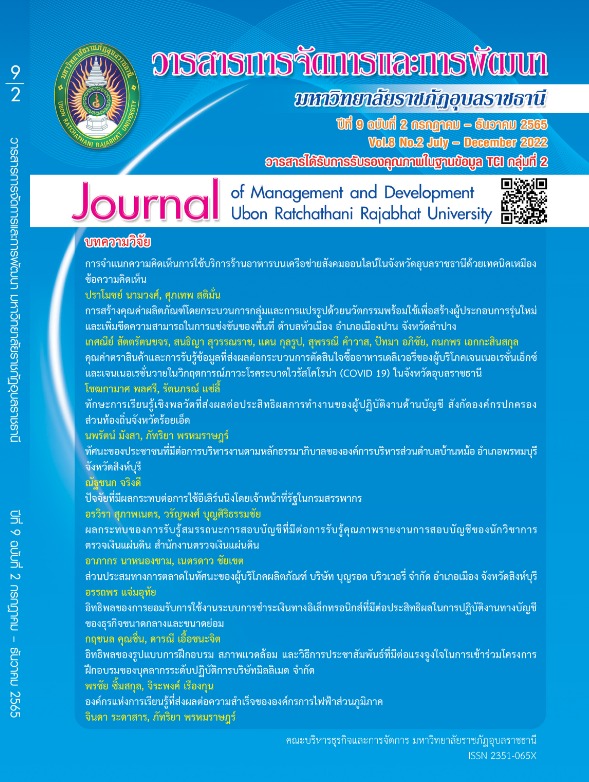ปัจจัยที่มีผลกระทบต่อการใช้อีเลิร์นนิงโดยเจ้าหน้าที่รัฐในกรมสรรพากร
คำสำคัญ:
อีเลิร์นนิง, ทฤษฎีรวมการยอมรับและการใช้เทคโนโลยี, ทัศนคติ, แรงจูงใจภายในบทคัดย่อ
จากสถานการณ์การแพร่ระบาดของโรคติดเชื้อไวรัสโควิด-19 สื่อการเรียนรู้อิเล็กทรอนิกส์หรือ
อีเลิร์นนิง (E-learning) ได้ถูกนำมาใช้อย่างแพร่หลายในกระบวนการพัฒนาทรัพยากรมนุษย์ และอาจเป็นประสบการณ์ที่แปลกใหม่สำหรับบุคลากรบางส่วน งานวิจัยชิ้นนี้มีวัตถุประสงค์เพื่อเปรียบเทียบความแตกต่างของปัจจัยด้านประชากรศาสตร์ที่ส่งผลต่อความตั้งใจในการใช้อีเลิร์นนิง และศึกษาปัจจัยต่าง ๆ ที่ส่งผลต่อความตั้งใจในการใช้อีเลิร์นนิง ประกอบด้วย ปัจจัยรวมด้านการยอมรับเทคโนโลยี ด้านทัศนคติ และด้านแรงจูงใจภายใน ผู้วิจัยใช้แบบสอบถามที่ผ่านการตรวจสอบคุณภาพของเครื่องมือ โดยมีค่าความน่าเชื่อถือของแบบสอบถามสัมประสิทธิ์แอลฟ่าของครอนบาคของแต่ละตัวแปรอยู่ระหว่าง .707 – .922 ในการเก็บข้อมูลจากกลุ่มตัวอย่าง ได้แก่ บุคลากรสำนักงานสรรพากร ภาค 1 (สำนักงานสรรพากรพื้นที่กรุงเทพมหานคร 1-9) จำนวน 308 คน วิเคราะห์ข้อมูลโดยใช้การแจกแจงความถี่ ค่าร้อยละ ค่าเฉลี่ย ค่าส่วนเบี่ยงเบนมาตรฐาน ใช้สถิติเชิงอนุมานในการทดสอบหาค่าที การวิเคราะห์ความแปรปรวนทางเดียว การวิเคราะห์ค่าสัมประสิทธิ์สหสัมพันธ์ และทดสอบหาความสัมพันธ์แบบถดถอยเชิงเส้น ผลการวิจัยความแตกต่างทางประชากรศาสตร์ พบว่า ช่วงอายุการทำงานที่แตกต่างกันส่งผลต่อความตั้งใจในการใช้อีเลิร์นนิงของกลุ่มตัวอย่างที่แตกต่างกัน ในส่วนของการวิเคราะห์ความถดถอยเชิงพหุคูณ พบว่า ปัจจัยที่ส่งผลในเชิงบวกต่อความตั้งใจในการใช้อีเลิร์นนิงที่ระดับนัยสำคัญทางสถิติ .01 ได้แก่ ด้านทัศนคติ (β = .447) และด้านแรงจูงใจภายใน (β = .135) ในขณะที่ปัจจัยด้านสภาพสิ่งอำนวยความสะดวก (β = .119) ด้านอิทธิพลทางสังคม (β = .109) ด้านความคาดหวังด้านประสิทธิภาพ (β = .093) และด้านความคาดหวังในความพยายาม (β = .092) ส่งผลเชิงบวกต่อความตั้งใจในการใช้อีเลิร์นนิงที่ระดับนัยสำคัญทางสถิติ .05
เอกสารอ้างอิง
กรมบัญชีกลาง. (2565). แผนพัฒนาบุคลากรประจำปีงบประมาณ พ.ศ. 2565. สืบค้นเมื่อ 3 กุมภาพันธ์ 2565 จาก https://www.cgd.go.th/cs/internet/internet/นโยบาย_กบค_1.2.html.
กรมสรรพากร. (2565). แผนการพัฒนาบุคลากรกรมสรรพากรประจำปีงบประมาณ พ.ศ. 2565. สืบค้นเมื่อ
มีนาคม 2565 จาก https://www.rd.go.th/62807.html.
จรัสพงศ์ คลังกรณ์. (2561). แนวทางเพื่อสร้างความเข้าใจให้กับประชาชนในเรื่องโมเดล ไทยแลนด์ 4.0. วารสารวิชาการ สถาบันเทคโนโลยีแห่งสุวรรณภูมิ, 4(1), 80-87.
ติรยา สรรพอุดม. (2560). ความต้องการในการพัฒนาตนเองของพนักงานบริษัทผู้ผลิตเครื่องดื่มแห่งหนึ่ง
ในนิคมอุตสาหกรรมอมตะนครจังหวัดชลบุรี. งานนิพนธ์รัฐประศาสนศาสตรมหาบัณฑิต มหาวิทยาลัยบูรพา.
ภานุมาศ หมอสินธ์ และคณะ. (2563). การอบรมออนไลน์เพื่อพัฒนาทรัพยากรมนุษย์. วารสารวิชาการ
สถาบันวิทยาการจัดการแห่งแปซิฟิค, 6(3), 347-357.
ภิรตา ภักดีสัตยพงศ์. (2564). PwC คาดแนวโน้มแย่งชิงทาเลนต์ที่มีทักษะด้านดิจิทัลพุ่งหลังโควิด-19.
สืบค้นเมื่อ 20 กุมภาพันธ์ 2565 จาก https://www.pwc.com/th/en/press-room/press-release/2021/press-release-23-06-21-th.html.
วรรณวิสา แย้มเกตุ. (2559). ปัจจัยที่มีผลต่อการพัฒนาตนเองในการทำงานของพนักงานธนาคารสายลูกค้าบุคคลของธนาคารเอกชนแห่งหนึ่ง. การค้นคว้าอิสระบริหารธุรกิจมหาบัณฑิต มหาวิทยาลัยกรุงเทพ.
สำนักโฆษก สำนักเลขาธิการนายกรัฐมนตรี. (2560). Thailand 4.0 ขับเคลื่อนอนาคตสู่ความมั่นคง มั่งคั่ง ยั่งยืน. สืบค้นเมื่อ 22 กรกฎาคม 2564 จาก https://spm.thaigov.go.th/FILEROOM/spm-thaigov/DRAWER004/GENERAL/DATA0000/00000368.PDF.
Abbad, M. M. M. (2021). Using the UTAUT Model to Understand Students’ Usage of E-learning Systems in Developing Countries. Education and Information Technologies, 26(6), 7205-7224.
Ajzen, I. & Fishbein, M. (1980). Understanding Attitudes and Predicting Social Behavior.
New Jersey: Prentice-Hall.
Bakar, A., Razak, F. & Abdullah, W. (2013). Assessing the Effects of UTAUT and Self-determination Predictor on Students Continuance Intention to Use Student Portal. World Applied Sciences Journal, 21(10), 1484-1489.
Berry, W. D. & Feldman, S. (1985). Multiple Regression in Practice (Quantitative Applications in the Social Sciences). California: Thousand Oaks.
Chanana, N. & Sangeeta, G. (2020). Employee Engagement Practices During COVID‐19 Lockdown. Journal of Public Affairs, 21(4), 1-8.
Davis, F., Bagozzi, R. & Warshaw, P. (1989) User Acceptance of Computer Technology: A Comparison of Two Theoretical Models. Management Science, 35(8), 982-1003.
Davis, F., Bagozzi, R. & Warshaw, P. (1992). Extrinsic & Intrinsic Motivation to Use Computers in the Workplace. Journal of Applied Social Psychology, 22(14), 1111–1132.
Jeoung, H. et al. (2011). Training Soft Skills via E-learning: International Chain Hotels. International Journal of Contemporary Hospitality Management, 23(6), 739-763.
Kanninen, E. (2009). Learning Styles and E-learning. Master’s Thesis, Degree of Electrical Engineering, Tampere University of Technology.
Kapo, A. et al. (2020). Continuous E-learning at the Workplace: the Passport for the Future of Knowledge. Information Technology & People, 34(5), 1462-1489.
Krejcie, R. V. & Morgan, D. W. (1970). Determining Sample Size for Research Activities. Educational and Psychological Measurement, 30, 607-610.
Lee, Y., Hsieh, Y. & Chen, Y. (2013). An Investigation of Employees' Use of E-learning Systems: Applying the Technology Acceptance Model. Taylor & Francis Behaviour & Information Technology, 32(2), 173–189.
Liaw, S. S. (2008). Investigating Students’ Perceived Satisfaction, Behavioral Intention, and Effectiveness of E-learning: A Case Study of the Blackboard System. Computers and Education, 51(2), 864-873.
Lwoga, E. T. & Komba, M. (2015). Antecedents of Continued Usage Intentions of Web-based Learning Management System in Tanzania. Education + Training, 57(7), 738-756.
Mielniczuk, E. & Laguna, M. (2017). Motivation and Training Initiation: Evidence from Poland. Journal of Workplace Learning, 29(1), 24-36.
Nunnally, J. C. (1978). Psychometric theory. (2nd ed.). New York: McGraw-Hill.
Ofori, D. et al. (2021). Using the UTAUT, Personal Innovativeness and Perceived Financial Cost to Examine Student’s Intention to Use E-learning. Journal of Science and Technology Policy Management, 26(10), 7205-7224.
Robbins, T. W. & Everitt. B. J. (1996). Neurobehavioral Bechanisms of Reward and Motivation. Current Opinion in Neurobiology, 6(2), 228–236.
Rovinelli, R. J. & Hambleton, R. K. (1977). On the Use of Content Specialists in the Assessment of Criterion-Referenced Test Item Validity. Dutch Journal of Educational Research, 2(1), 49–60.
Sahu, K. K. & Dubey, P. (2021). Investigating Various Factors that Affect Students’ Adoption Intention to Technology-enhanced Learning. Journal of Research in Innovative Teaching & Learning, 15(1), 110-131.
Samsudeen, S. N. & Mohamed, R. (2019). University Students’ Intention to Use E-learning Systems. Interactive Technology and Smart Education, 16(3), 219-238.
Tarhini, A. et al. (2017). Factors Influencing Students' Adoption of E-learning: A Structural Equation Modeling Approach. Journal of International Education in Business, 10(2), 164-182.
Thongsri, N. et al. (2018). Integrating UTAUT and UGT to Explain Behavioral Intention to Use
M-learning: A Developing Country’s Perspective. Journal of Systems and Information Technology, 20(3), 278-297.
Venkatesh, V. et al. (2003). User Acceptance of Information Technology: Toward A Unified View. MIS Quarterly, 27(3), 425-278.

ดาวน์โหลด
เผยแพร่แล้ว
ฉบับ
ประเภทบทความ
สัญญาอนุญาต

อนุญาตภายใต้เงื่อนไข Creative Commons Attribution-NonCommercial-NoDerivatives 4.0 International License.
บทความที่ตีพิมพ์ในวารสาร เป็นงานเขียนของนักวิจัยหรือนักวิชาการแต่ละท่านโดยเฉพาะ มิใช่ความเห็นและความรับผิดชอบใดๆ ของกองบรรณาธิการวารสารการจัดการและการพัฒนา มหาวิทยาลัยราชภัฏอุบลราชธานี
บทความ ข้อมูล เนื้อหา รูปภาพ ฯลฯ ที่ได้รับการตีพิมพ์ในวารสารฯ ถือเป็นลิขสิทธิ์ของวารสารการจัดการและการพัฒนา มหาวิทยาลัยราชภัฏอุบลราชธานี หากบุคคลหรือหน่วยงานใดต้องการนำทั้งหมดหรือส่วนหนึ่งส่วนใดไปเผยแพร่ต่อหรือเพื่อกระทำการใดๆ จะต้องทำการอ้างอิงมายังวารสาร




